How to Fix Stop Error Code 0x00000667
Several Windows users are encountering the 0x00000667 (Invalid Command_line Argument) stop error code when running a particular application or when attempting to put the PC to sleep or hibernation. This problem is confirmed to happen on Windows 7, Windows 8.1, and Windows 10.

As it turns out, there are several different causes that might contribute to the apparition of this error code. Here’s a shortlist of scenarios that are known to cause this particular error:
- The conflict caused by AVG – One of the most common instances with the potential of causing this issue is a kernel conflict facilitated by AVG Antivirus. If this conflict is applicable to your current situation, the only way to fix it (if updating the security suite doesn’t work) is to uninstall the AVG suite from your computer.
- Different kind of conflict – If you are not actively using AVG antivirus, it’s also possible that you’re dealing with a different kind of 3rd party conflict. In case you don’t have possible culprits, the best thing you can do is to use an older System Restore snapshot to restore your computer back to a healthy state in which this conflict was not occurring.
- Virtualization Conflict – If you’re using an Android-based emulator or a virtual machine toolkit like VMWare or VirtualBox, it’s possible that the default virtualization technology of your CPU is conflicting with Hyper-V (Windows Component). To fix this inconsistency, you should disable Hyper-V from their Windows Features menu.
- Virtualization is disabled from BIOS / UEFI – If you’re encountering this critical stop error while attempting to use an application that requires virtualization technology (NOX, VMWare, Virtualbox, etc.) chances are you’re seeing this error because SVM or VT-X is disabled from your BIOS or UEFI Menus. If this scenario is applicable, you should be able to fix the problem by enabling this technology from your BIOS or UEFI settings.
- Intel HAXM installation is missing or outdated – In case you’re encountering this problem while using an Android Emulator like BlueStacks or Nox with an Intel CPU, you might be able to fix this error code by installing or updating your current HAXM (Hardware Accelerated Execution Manager) version.
- Windows installer is partially de-registered – In the event that you’re seeing this error only when trying to install a program, you’re most likely dealing with a partially de-registered version of Windows Installer. In this case, you should be able to fix the issue by using an elevated CMD prompt to re-register the Windows Installer component.
- Windows Installer is Disabled – If you’re experiencing a BSOD associated with this error while attempting to use Windows Installer, it’s also possible that you’re seeing this error because the service is disabled. In this case, you can fix the problem by forcing the service to start from the Services screen.
Now that you know every potential culprit, here’s a shortlist of methods that other users have confirmed to be effective in fixing the 0x00000667 stop error code:
Method 1: Uninstalling AVG (if applicable)
As it turns out, one of the most common scenarios that might end up causing this stop error code is a software conflict facilitated by AVG antivirus. This is confirmed by dozens of users that have successfully managed to make the 0x00000667 stop after uninstalling AVG from the Programs and Features menu.
Note: Disabling the real-time protection is not enough since the same security rules will remain firmly in place. You should start by making sure that you’re using the latest version of AVG.
According to affected users, this conflict can occur on both Windows 7 and Windows 10. If this scenario is applicable and you’re currently using AVG AV as the primary security suite on your operating system, follow the instructions below to uninstall it (and switch over to Windows Defender) in order to make the BSOD crashes to stop:
- Press Windows key + R to open up a Run dialog box. Next, type ‘appwiz.cpl’ inside the text box and press Enter to open un the Programs and Features screen.
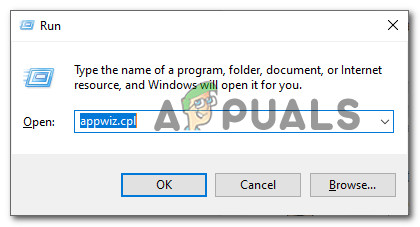
Opening the Programs and Features screen - Inside the Programs and Features screen, scroll down through the list of installed products and locate Avast. When you see it, right-click on it and choose Uninstall from the context menu.
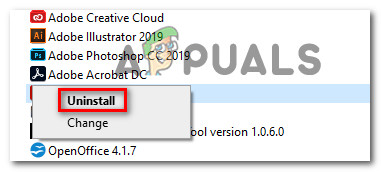
Uninstall Avast - Inside the uninstallation screen, follow the on-screen prompts to complete the uninstallation process, then restart your computer and see if the 0x00000667 stop error stops occurring.Note: Once your computer boots back up, Windows Defender will automatically kick in, so don’t worry about leaving your system unprotected from potential security threats.
In case this method was not applicable or the same error is still popping up even after uninstalling AVG, move down to the next method below.
Method 2: Using System Restore
If you only started seeing this issue recently, it’s likely that a recent software change is actually producing this error code due. If you have no suspects, your best choice at getting the issue fixed without having to do a clean install is to use the System Restore utility.
Note: The culprit behind the 0x00000667 error code can occur for a variety of reasons including a bad Windows update, a botched driver installation, two conflicting 3rd party applications, etc.
You can use the System Restore utility to use a previously created snapshot to return your computer to a previous state in time in which this stop error code is no longer occurring. But keep in mind that doing this will also revert any installed applications, installed Windows Update, driver, and even undo any custom settings that you have established since.
In case you want to give this method a try, here are some step-by-step instructions on finding & using the best System Restore snapshot to fix the 0x00000667 error.
Note: If you have the time to do this thoroughly, you should also remove any remnant files left behind by the uninstallation of the 3rd party AV.
In case you already tried using System Restore to no avail or you were unable to find a viable restore snapshot created before the apparition of this error, move down to the next potential fix below.
Method 3: Disabling Hyper-V (if applicable)
If you’re using Nox player or a different Android-based emulator, it’s very possible that it’s conflicting with the Hyper-V service that’s enabled by default on your Windows computer. In this case, you should be able to prevent the 0x00000667 error from appearing again by accessing the Windows Features menu and disabling the Hyper-V Service before initiating a restart.
Update: This type of conflict is also reported to occur between virtual machine software like Virtualbox and VMWare.
This method was confirmed to work by a lot of affected users and it’s particularly known to be effective on Windows 10.
If you find yourself in the same scenario, follow the instructions below to disable Hyper-V from the Windows Features menu:
- Press Windows key + R to open up a Run dialog box. Next, type ‘appwiz.cpl’ and press Enter to open up the Programs and Features menu.

Type appwiz.cpl and Press Enter To Open Installed Programs Page - Once you’re inside the Programs and Features menu, use the menu on the left to click on Turn Windows features on or off. When you’re prompted by the User Account Control prompt, click Yes to grant admin access.
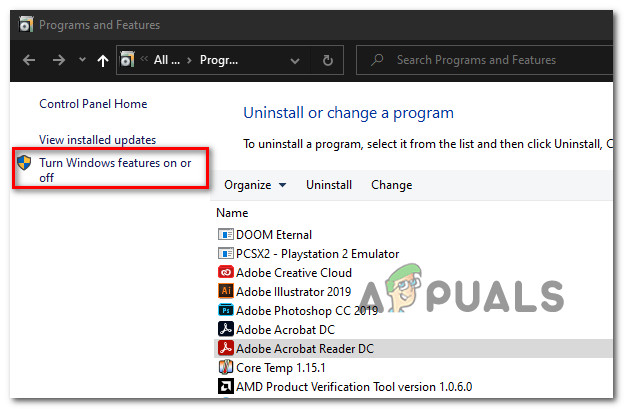
Accessing the Windows features screen - Inside the Windows Features screen, scroll down through the list of Windows features and uncheck the box associated with Hyper-V. Next, click on Ok to save the changes.
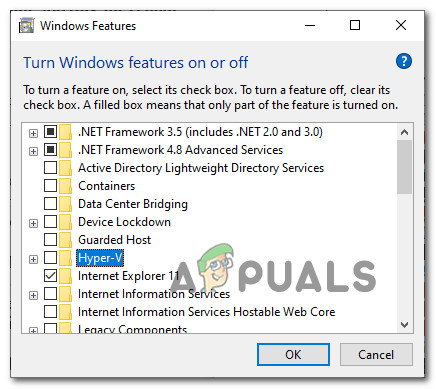
Disabling Hyper-V - Restart your computer and see if the problem is fixed once the next startup is complete.
If you’re still encountering the same 0x00000667 error even though you’ve just disabled the Hyper-V features, move down to the next method below.
Method 4: Enabling Virtualization from BIOS or UEFI
If you’re encountering this problem when using some kind of application that uses virtualization technology (Android Studio, Nox, VMWare, VirtualBox, etc.) it’s possible to encounter the 0x00000667 error code because SVM (Secure Virtual Machine) or Intel’s equivalent (Intel VT-X / Intel Virtualization) is disabled in your BIOS or UEFI settings.
If this scenario is applicable, you should be able to fix the problem by accessing your BIOS or UEFI settings and enabling the virtualization technology – This will allow the applications that rely on this technology to run normally without encountering the same 0x00000667 error code.
Keep in mind that enabling SVM or VT-X is a different procedure depending on the motherboard manufacturer. However, the exact steps you need to perform ar similar on every BIOS or UEFI version:
Start by pressing the Setup key immediately after you boot up your computer.
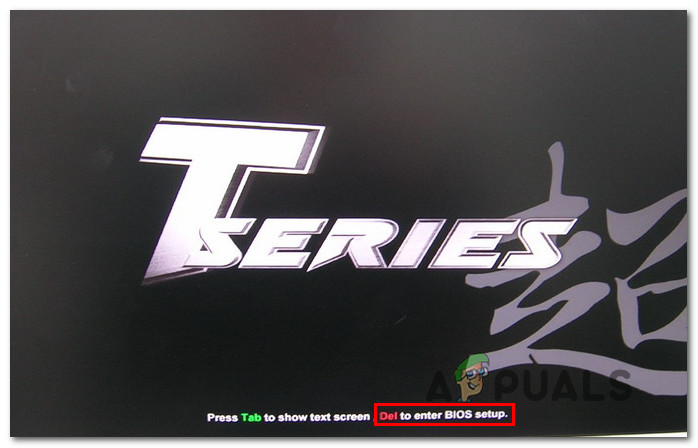
Once you’re inside the BIOS or UEFI settings of your motherboard, look for an option SVM Mode or Inter Virtualization (depending on your CPU manufacturer) and enable it before saving the changes.
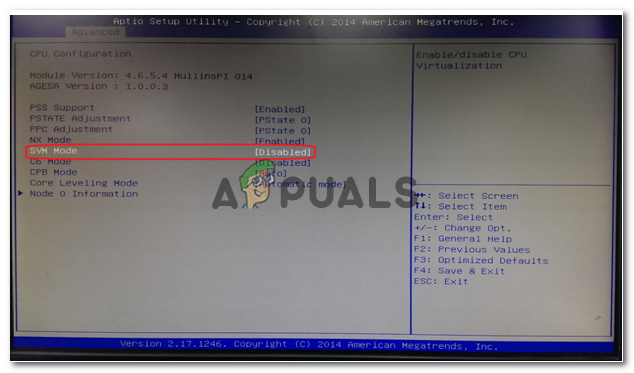
Note: Typically, you can find this option inside the Advanced / Expert tab under CPU Configuration / Virtualization.
Once the virtualization technology has been enabled, save the changes before restarting your computer and allowing it to boot normally. After your computer boots back up, repeat the action that was previously causing the 0x00000667 error.
In case the issue is still not resolved, move down to the next potential fix below.
Method 5: Installing Intel Haxm (if applicable)
If you’re encountering this stop error code while using an Android Emulator like BlueStacks or Nox when testing apps that are still in development mode, you might be able to fix the problem by installing Intel Xaxm (only applicable if your PC is using Intel’s Virtualization technology – Intel VT).
In this case, you should be able to fix the problem by downloading and installing the latest official Intel Haxm directly or using SDK Manager.
If this scenario is applicable, follow the instructions below to fix the 0x00000667 error by installing the Standalone Intel HAXM on Windows. Here’s what you need to do:
- Download the installer package of Intel HAXM from the official download page. Additionally, you can download the latest build directly via the SDK Manager.
- Once the download is complete, run the installer with admin rights and click on Yes when prompted by the User Account Control prompt.
Note: If you already have an existing version of Intel HAXM, you will see a notification dialog box where you need to click on Yes.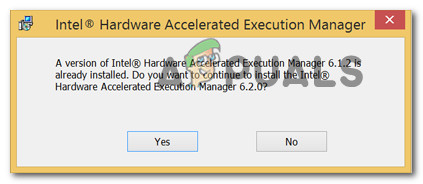
Installing Intel HAXM - Next, follow the on-screen prompts to complete the installation, then restart your computer at the end of this procedure.

Completing the installation of Intel HAXM Manager - Once the next startup is complete, repeat the action that was previously causing the error and see if the problem is now fixed.
In case the same issue is still occurring, move down to the next potential fix below.
Method 6: Re-Registering Windows Installer
If you’re encountering the 0x00000667 error coupled with the ‘Invalid command-line argument’ message when attempting to install a new program using Windows Installer or when using a component Windows Installer SDK, you might be able to fix the problem by temporarily unregistering the Windows Installer component from an elevated CMD prompt before registering it again.
Several affected users that found themselves in a similar scenario have confirmed that the procedure below has finally allowed them to fix the problem. Here’s what you need to do:
- Press Windows key + R to open up a Run dialog box. Next, type ‘cmd’ inside the text box and press Ctrl + Shift + Enter to open up an elevated Command Prompt.

Opening an elevated Command Prompt - Inside the elevated Command Prompt, type the following command and press Enter to temporarily de-register the Windows Installer:
msiexec /unreg
- Once the command is processed successfully and you get the success message, insert the following command and press Enter to register the Windows Installer once again:
msiexec /regserver
- After the second command is processed successfully, restart your computer once again, and repeat the action that was previously causing the error.
In case the same 0x00000667 error is still occurring, move down to the next potential fix below.
Method 7: Enabling the Windows Installer service
If none of the methods above have worked in your case and you’re experiencing this type of error when doing something that’s handled by a Windows installer, you should also take the time to ensure that the main service behind the Windows installer is running uninterrupted.
Several affected users that were previously dealing with the same 0x00000667 error have confirmed that they managed to fix the issue by accessing the Servicing screen and noticing that the Windows Installer service was disabled. They managed to fix it by forcing the services to start before repeating the operation that was causing the error.
If this scenario is applicable to your scenario, follow the instructions below to re-configure the Windows Installer service to be on-call whenever it’s needed:
- Press Windows key + R to open up a Run dialog box. Next, type ‘services.msc‘ inside the text box and press Enter to open up the Services screen.
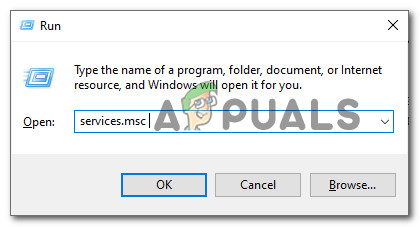
Opening the Services screen - Inside the Services screen, scroll down through the list of services and locate Windows Installer. When you finally see it, right-click on it and choose Properties from the context menu.
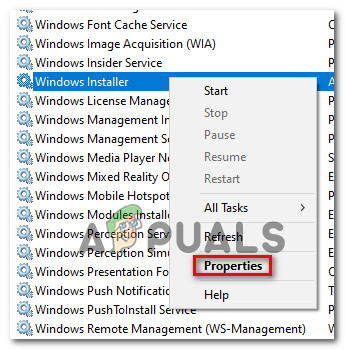
Properties screen of Windows installer - Inside the Properties screen of Windows Installer, access the General tab from the menu at the top, then click on Start to force the service to start and wait until it’s started before closing the window.
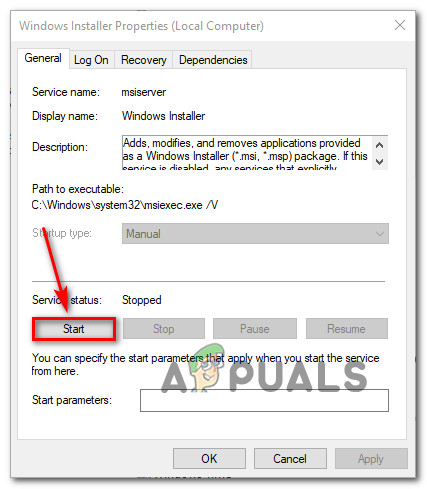
Starting the Windows Installer - Repeat the action that was previously causing the 0x00000667 error and see if the problem is now fixed.





